|
|
|
|
|
Oil On
Canvas, Real Flavor of Old Masters
|
|

|
ARTWORKS
INDEX
A B C D E F G H I J K L M N O P Q R S T U V W X Y Z |
ARTISTS
INDEX
A B C D E F G H I J K L M N O P Q R S T U V W X Y Z |
|
|
| | |
|
|
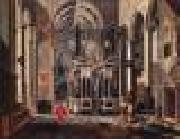 |
BASSEN, Bartholomeus van -- Click Here
|
|
Dutch Baroque Era Painter, 1590-1652
Dutch painter and architect. He was the grandson of Bartolt Ernst van Bassen from Arnhem, who was Clerk of the Court of Holland in The Hague. In 1613 van Bassen was admitted to the Guild of St Luke in Delft, having come from outside the city. In 1622 he became a member of the Guild in The Hague where he was also municipal architect from 1638 until his death. He married in 1624; his son Aernoudt married a daughter of Cornelis van Poelenburch. |
|
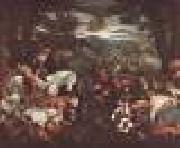 |
BASSANO, Leandro -- Click Here
|
|
Italian Mannerist Painter, 1557-1622
Son of Jacopo Bassano. He entered the workshop of his father when very young and soon developed a style of painting strongly based on drawing. Leandro used fine brushwork, with cool, light colours, smoothly applied in well-defined areas, unlike his father, who painted with dense and robust brushstrokes. From 1575 Leandro's participation in the workshop increased, and he became his father's principal assistant after Francesco Bassano il giovane moved to Venice in 1578. |
|
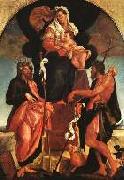 |
BASSANO, Jacopo -- Click Here
|
|
Italian High Renaissance Painter, ca.1510-1592
Jacopo Bassano (also known as Jacopo da Ponte, c. 1515 - 13 February 1592) was an Italian painter who was born and died in Bassano del Grappa near Venice, from which he adopted the name.
His father Francesco Bassano the Elder was a "peasant artist" and Jacopo adopted some of his style as he created religious paintings with novel features including animals, farmhouses, and landscapes. He trained initially with his father, Francesco da Ponte the Elder, then in the studio of Bonifacio Veneziano. His mature style, however, followed the example of Titian. Having worked in Venice and other Italian towns, he established a workshop in Bassano with his four sons: Francesco the Younger (1549?C1592), Girolamo (1566?C1621), Giovanni Battista (1553?C1613), and Leandro (1557?C1622). They shared his style, and some works are difficult to attribute precisely. |
|
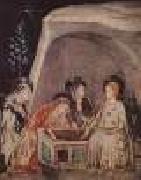 |
BASSA, Ferrer -- Click Here
|
|
Spanish painter
active 1324-1348
His workshop was in Calle Cucurulla, Barcelona, and commissions from a variety of patrons, mostly royal, are documented. In 1324 he was paid for painting two chapels and two crosses for the church at Sitges. Between c. 1333 and c. 1335 he illuminated a book on the Usages of Barcelona and Customs of Catalonia for Alfonso IV of Aragon, and in 1335 he was paid for an altarpiece. Further payments, in 1339 and 1340, were for two altarpieces for the chapel of the Aljaferea Palace (a Moorish palace) in Saragossa. About 1340 he received a commission for an altarpiece of St Hilary for the diocese of Lleida (Sp. Lerida). In 1341 Bassa had begun work on three altarpieces for the Episcopal See at Lleida, commissioned by Ot de Montacada (c. 1290-1341). In 1342 Peter IV (the Ceremonious) of Aragon asked his wife, Maria of Navarre, to send him a Book of Hours illuminated by Ferrer Bassa, and in the same year the artist was also paid for a commission by Queen Constanza of Mallorca. In 1343 and 1344 he was paid for an altarpiece and other works for the chapel of the Aljaferea Palace in Saragossa and for an altarpiece for the chapel of the royal palace at Barcelona. In 1344 Bassa was commissioned to decorate the S Miguel Chapel, then the cell of the abbess in the Pedralbes Monastery, Barcelona, although he only started work in 1346. He was involved in further royal commissions in 1345, including an altarpiece for the chapel of the castle at Perpignan. |
|
|
|
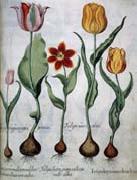 |
Basilius Besler -- Click Here
|
|
1561-1629,was a respected Nuremberg apothecary and botanist, best known for his monumental Hortus Eystettensis. He was curator of the garden of Johann Konrad von Gemmingen, prince bishop of Eichstätt in Bavaria. The bishop was an enthusiastic botanist who derived great pleasure from his garden, which was the only important European botanical garden outside Italy. The gardens surrounded the bishop's palace, Willibaldsburg, which was built on a hill overlooking the town. These gardens had been started in 1596 and designed by Besler's colleague, Joachim Camerarius, the Younger (1534-1598), a physician and botanist. Upon Camerarius' death in 1598, Besler had the remainder of Camerarius' plants moved to Eichstätt and carried on the work of planting and supervision. The bishop commissioned Besler to compile a codex of the plants growing in his garden, a task which Besler took sixteen years to complete, the bishop dying shortly before the work was published. Besler had the assistance of his brother and a group of skilled German draughtsmen and engravers, including Sebastian Schedel, an accomplished painter, and Wolfgang Kilian, a skilled engraver from Augsburg. Kilian and his team engraved the initial copper plates, but after the bishop??s death, the operations moved to N??rnberg and a new team of engravers, among whom were Johannes Leypold, Georg Gärtner, Levin and Friedrich van Hulsen, Peter Isselburg, Heinrich Ulrich, Dominicus Custos and Servatius Raeven. Camerarius' nephew, Ludwig Jungermann (1572-1653), was a botanist and wrote the lion's share of the descriptive text. The work was named Hortus Eystettensis (Garden at Eichstätt). The emphasis in botanicals of previous centuries had been on medicinal and culinary herbs, and these had usually been depicted in a crude manner. The images were often inadequate for identification, and had little claim to being aesthetic. The Hortus Eystettensis changed botanical art overnight. The plates were of garden flowers, herbs and vegetables, exotic plants such as castor-oil and arum lilies. |
|
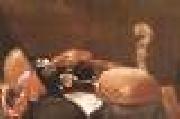 |
BASCHENIS, Evaristo -- Click Here
|
|
Italian Baroque Era Painter, 1617-1677
Evaristo Baschenis (December 7, 1617 ?C March 16, 1677) was an Italian Baroque painter of the 17th century, active mainly around his native city of Bergamo. He was born to a family of artists. He is best known for still lifes, most commonly of musical instruments. This could explain his friendship with a family with notable violin makers from Cremona. Still-life depictiona were uncommon as a thematic among Italian painters prior to the 17th century. Baschenis, along with the more eccentric 16th century painter Milanese Arcimboldo, represents provincial outputs with idiosyncratic tendencies that appear to appeal to the discernment of forms and shapes rather than grand manner themes of religious or mythologic events. For Arcimboldo, the artifice is everything; for Baschenis, the items, man-made musical instruments, have a purpose and a beauty even in their silent geometry. One source for his photographic style of still life could be Caravaggio's early painting of peaches, or alternatively, Dutch paintings. The most faithful imitator of his style is a younger contemporary Bergamese, Bartolomeo Bettera. Baschenis is a contemporary of the Bergamese portrait artist, Carlo Ceresa, and appears to have been influential for the Modenese artist Cristoforo Munari. |
|
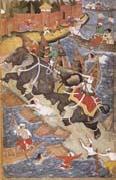 |
Basawan -- Click Here
|
|
Indian Miniaturist, active ca.1556-1600,Indian miniature painter. One of the great talents to flourish under the emperor Akbar (reg 1556-1605), he was a prolific painter who contributed to virtually all the great illustrated manuscripts executed in the imperial workshops over a span of some 40 years. While most Mughal artists were concerned with the importance of line, colour and surface pattern, Basawan, with a greater understanding of the techniques of imported European works, developed a palette closer to that of European oil painting and dissolved outlines to create greater three-dimensionality. In his work, surface patterns are subservient to a dramatic spatial penetration of the picture plane. These traits were quite new within both Indian and Islamic traditions, and Basawan led the vanguard in adopting them. His work is remarkable also for the complexity of his compositions, his skill at giving roundness and density to his figures and his sensitive portrait-like faces. |
|
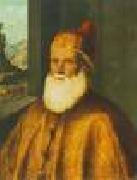 |
BASAITI, Marco -- Click Here
|
|
Italian Painter, ca.1470-1530
Marco Basaiti (c. 1470 ?C 1530) was a Venetian painter and a rival of Giovanni Bellini. His best known works are Christ Praying in the Garden (1516) and the Calling of St. Peter and St. Andrew.
Christ praying in the GardenThought to have originated in the Balkans, his date of birth and arrival in Venice are not known, but he began to paint actively around 1496. He is generally believed to have learned to paint in the workshops of Alvise Vivarini. Basaiti worked primarily with religious themes, but he also did portraits. Contrary to the trends of the time, he used very bright colours in rendering his religious subjects. |
|
 |
Bartolommeo Caporali -- Click Here
|
|
Italian Early Renaissance Painter, ca.1420-1505 |
|
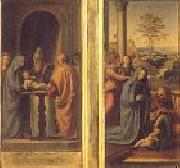 |
BARTOLOMEO, Fra -- Click Here
|
|
b. 1473, Firenze, d. 1517
b. 1473, Firenze, d. 1517
He was born in Savignano di Prato, Tuscany. He received the nickname of Baccio della Porta for his house was near the Porta ("Gate") San Pier Gattolini.
Starting from 1483 or 1484, by recommendation of Benedetto da Maiano, he apprenticed in the workshop of Cosimo Rosselli. In 1490 or 1491 he began a collaboration with Mariotto Albertinelli. In the late 1490s Baccio was drawn to the teachings of Fra Girolamo Savonarola, who denounced what he viewed as vain and corrupt contemporary art. Savonarola argued for art serving as a direct visual illustration of the Bible to educate those unable to read the book. From 1498 is his famous portrait of Savonarola, now in the Museo Nazionale di San Marco in Florence. The following year he was commissioned a fresco of the Universal Judgement for the Ospedale di Santa Maria Nuova, completed by Albertinelli and Giuliano Bugiardini when Baccio became a Dominican friar on July 26, 1500. The following year he entered the convent of San Marco.
He renounced painting for several years, not resuming until 1504 when he became the head of the monastery workshop in obedience to his superior. In that year he began a Vision of St. Bernard for Bernardo Bianco's family chapel in the Badia Fiorentina, finished in 1507. Soon thereafter, Raphael visited Florence and befriended the friar. Bartolomeo learned perspective from the younger artist, while Raphael added skills in coloring and handling of drapery, which was noticeable in the works he produced after their meeting. With Raphael, he remained on the friendliest terms, and when he departed from Rome, left in his hands two unfinished pictures which Raphael completed.
At the beginning of 1508 Bartolomeo moved to Venice to paint a Holy Father, St. Mary Magdalene and St. Catherine of Siena for the Dominicans of San Pietro Martire in Murano, influenced somewhat by Venetian colorism. As the Dominicans did not pay the work, he took it back to Lucca, where it can be seen now. Also in Lucca, in the October 1509, he painted by Albertinelli an altarpiece with Madonna and Child with Saints for the local cathedral. On November 26, 1510 Pier Soderini commissioned him an altarpiece for the Sala del Consiglio of Florence, now in the Museum of San Marco. Two years later he finished another altarpiece for the cathedral of Besancon. |
|
 |
Bartolomeo Vivarini -- Click Here
|
|
Venice ca 1432-after 1491 |
|
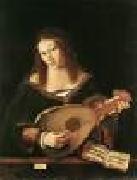 |
BARTOLOMEO VENETO -- Click Here
|
|
Italian Painter, ca.1470-1531
Italian painter. He worked in Venice, the Veneto and Lombardy in the early decades of the 16th century. Knowledge of him is based largely on the signatures, dates and inscriptions on his works. His early paintings are small devotional pictures; later he became a fashionable portraitist. His earliest dated painting, a Virgin and Child (1502; Venice, priv. col., see Berenson, i, pl. 537), is signed 'Bartolomeo half-Venetian and half-Cremonese'. The inscription probably refers to his parentage, but it also suggests the eclectic nature of his development. This painting is clearly dependent on similar works by Giovanni Bellini and his workshop, but in a slightly later Virgin and Child (1505; Bergamo, Gal. Accad. Cararra) the sharp modelling of the Virgin's headdress and the insistent linear accents in the landscape indicate Bartolomeo's early divergence from Giovanni's depiction of light and space. An inscription on his Virgin and Child of 1510 (Milan, Ercolani Col.) states that he was a pupil of Gentile Bellini, an assertion supported by the tightness and flatness of his early style. The influence of Giovanni is still apparent in the composition of the Circumcision (1506; Paris, Louvre), although the persistent stress on surface patterns and the linear treatment of drapery and outline is closer to Gentile. Bartolomeo's experience as a painter at the Este court in Ferrara (1505-8) probably encouraged the decorative emphasis of his style. In the half-length Portrait of a Man (c. 1510; Cambridge, Fitzwilliam) the flattened form of the fashionably dressed sitter is picked out against a deep red curtain so that the impression of material richness extends across the entire picture surface. |
|
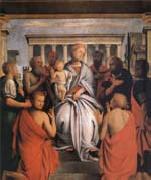 |
Bartolomeo Suardi -- Click Here
|
|
c. 1465?C1530,was an Italian painter and architect, mainly active in his native Milan. He was born in Milan, the son of Alberto Suardi, but his biography remains unclear, and was long complicated by two "Pseudo-Bramantinos". He was trained by Donato Bramante, adopting a diminutive form of his master's name. This training gave him influences from by the Urbino quattrocento tradition of immobile realism, and later he assimilated some elements of the style of Leonardo, after he arrived in Milan, although in other respects he remained faithful to his training in the style of Central Italy. He is documented in late 1508 as helping in the decoration of the Vatican Stanze though nothing remains of his work there, and by 1509 he was back in Milan. His style changed considerably during his career, and also shows strongly individual traits. His main influences were the serene and sometimes unnatural quietist classicism of Piero della Francesca, Leonardo da Vinci, and Ercole de' Roberti |
|
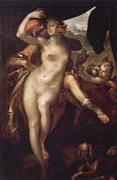 |
Bartolomeo Spranger -- Click Here
|
|
Belgium
1546-1611 |
|
 |
Bartolomeo Passerotti -- Click Here
|
|
(1529-1592) was an Italian painter of the mannerist period, who worked mainly in his native Bologna.
He traveled to Rome in the mid-16th century, where he worked under Girolamo Vignola and Taddeo Zuccari. Upon returning to Bologna, he accumulated a large studio, and influenced many Bolognese who would later play a role in the rise of the Baroque. Annibale Carracci (whose brother Agostino studied with Passarotti) was influenced by Passarotti's genre scenes in a select set of paintings (such as The Beaneater and The Butcher's Shop, the latter being originally attributed to Passarotti). Lucio Massari and Francesco Brizzi were among his pupils. Four of Passarotti's sons, including Ventura, Aurelio, Tiburzio, and Passarotto were painters.
|
|
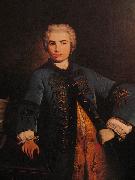 |
Bartolomeo Nazari -- Click Here
|
|
Bartolomeo Nazari (May 31, 1693 - August 24, 1758) was an Italian painter of the late-Baroque, mainly active in Venice as a portraitist.
Born in Clusone, near Bergamo. By 1716, he had become an apprentice under Angelo Trevisani, but visited in 1723 the Roman studio of Angelo's brother, the Venetian Francesco Trevisani, and then also studied with Benedetto Luti. Nazari likely knew personally Fra Galgario, the renowned portraitist from Bergamo, and is described by some as a pupil. He returns to Venice in 1724, and is registered with the Fraglia dei Pittori by 1726. In 1744, he traveled to Frankfurt to paint the emperor Charles VII and his family and other members of the court. In 1756, he was inducted into the newly founded Accademia of Venice. His son Nazario Nazari was also a painter. Among his patrons was Consul Joseph Smith and the former general Johann Matthias von der Schulenburg (who owned over eight diverse portrait paintings). He painted the portraits of a number of operatic singers including Farinelli. He died returning from Genoa, where he had painted the Doge. |
|
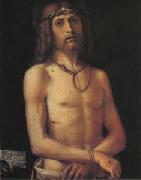 |
Bartolomeo Montagna -- Click Here
|
|
Orzinuovi ca 1450-Vicenza 1523
.Painter and draughtsman. Montagna is first documented in 1459 in Vicenza as a minor and, still a minor, in 1467. In 1469 he is recorded as a resident of Venice. In 1474 he was living in Vicenza where, in 1476 and 1478, he was commissioned to paint altarpieces (now lost). He has variously been considered a pupil of Andrea Mantegna (Vasari), Giovanni Bellini, Antonello da Messina, Alvise Vivarini, Domenico Morone and Vittore Carpaccio. While none of these artists, except Carpaccio, was irrelevant to Montagna's stylistic formation, scholars agree that Giovanni Bellini was the primary influence on his art. He may have worked in Bellini's shop around 1470. Several of Montagna's paintings of the Virgin and Child in which the influence of Antonello da Messina is especially marked (e.g. two in Belluno, Mus. Civ.; London, N.G., see Davies, no. 802) are likely to be close in date to Antonello's sojourn in Venice (1475-6); they are therefore best considered Montagna's earliest extant works (Gilbert, 1967) rather than as an unexplained parenthesis around 1485 between two Bellinesque phases (Puppi, 1962). These early paintings appear to be followed by others in which the geometrically rounded forms derived from Antonello become more slender and sharper-edged. Their figures are imbued with a deeply felt, individual humanity, sometimes austere and minatory, sometimes tender. Among them are some larger-scale works, |
|
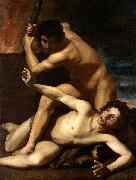 |
Bartolomeo Manfredi -- Click Here
|
|
(baptised 25 August 1582 - 12 December 1622) was an Italian painter, a leading member of the Caravaggisti (followers of Michelangelo Merisi da Caravaggio) of the early 17th century.
Manfredi was born in Ostiano, near Cremona. He may have been a pupil of Caravaggio in Romeat his famous libel trial in 1603 Caravaggio mentioned that a certain Bartolomeo, accused of distributing scurrilous poems attacking Caravaggio's detested rival Baglione, had been a servant of his. Certainly the Bartolomeo Manfredi known to art history was a close follower of Caravaggio's innovatory style, with its enhanced chiaroscuro and insistence on naturalism, with a gift for story-telling through expression and body-language.
Caravaggio in his brief careerehe rocketed to fame in 1600, was exiled from Rome in 1606, and was dead by 1610 had a profound effect on the younger generation of artists, particularly in Rome and Naples. And of these Caravaggisti (followers of Caravaggio), Manfredi seems in turn to have been the most influential in transmitting the master's legacy to the next generation, particularly with painters from France and the Netherlands who came to Italy. Unfortunately no documented, signed works by Manfredi survive, and several of the forty or so works now attributed to him were formerly believed to be by Caravaggio. The steady disentangling of Caravaggio from Manfredi has made clear that it was Manfredi, rather than his master, who was primarily responsible for popularising low-life genre painting among the second generation of Caravaggisti.
Manfredi was a successful artist, able to keep his own servant before he was thirty years old, "a man of distinguished appearance and fine behaviour" according to the biographer Giulio Mancini, although seldom sociable. He built his career around easel paintings for private clients, and never pursued the public commissions upon which wider reputations were built, but his works were widely collected in the 17th century and he was considered Caravaggio's equal or even superior. His Mars Chastising Cupid offers a tantalising hint at a lost Caravaggio: the master promised a painting on this theme to Mancini, but another of Caravaggio's patrons, Cardinal Francesco Maria Del Monte, had taken it, and Mancini therefore commissioned Manfredi to paint another for him, which Mancini considered Manfredi's best work.
Manfredi died in Rome in 1622. Gerard Seghers (or Segers; 1589-1651) was one of his pupils
|
|
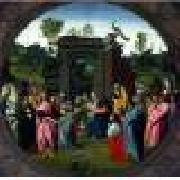 |
BARTOLOMEO DI GIOVANNI -- Click Here
|
|
Italian Early Renaissance Painter, active 1475-1511
Bartolomeo di Giovanni, also known as Bartolommeo di Giovanni and as Alunno di Domenico, was an early renaissance Italian painter of the Florentine School who was active from about 1480 until his death in 1501. He studied with and assisted Domenico Ghirlandaio, painting the predella of Ghirlandaio's Adoration of the Magi in the Ospedale degli Innocenti (Foundling Hospital) in Florence, in 1488. Bartolomeo di Giovanni also worked under the guidance of Sandro Botticelli. |
|
 |
bartolomeo della gatta -- Click Here
|
|
(1448 -1502), born Pietro di Antonio Dei, was an Italian (Florentine) painter, illuminator, and architect. He was the son of a goldsmith. He was a colleague of Fra Bartolommeo. In 1468, Bartolomeo became a monk in the Order of Camaldoli, probably in the Church of Santa Maria degli Angeli in Florence, which his brother Nicolo had already entered. Upon taking holy orders, he changed his name to Bartolomeo. About 1481, he was summoned to Rome where he contributed to the cycle of frescos on the walls of the Sistine Chapel. Bartolomeo eventually became Abbot of San Clemente in Arezzo. He died in 1502 and was buried in the Abbey of San Clemente.
|
|
 |
Bartolomeo Caporali -- Click Here
|
|
(c. 1420-c. 1505 ; active 1454-1499) was an Italian painter born and active in Perugia. He painted a Madonna and Saints (1487) for the church of Santa Maria Maddalena at Castiglione del Lago.
|
|
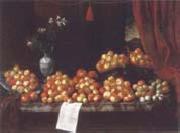 |
Bartolomeo Bimbi -- Click Here
|
|
1648-1723,was a Florentine painter of still lifes spurred by his patrons including Cosimo III, Grand Duke of Tuscany to paint large canvases of flora and fauna for the Medici Villa dell'Ambrogiana and della Topaia, now conserved in the Pitti Palace and the Museo Botanico dell'Universita. He partly was following the tradition of Jacopo Ligozzi. He was a pupil of Lorenzo Lippi and Onorio Marinari. Others claim he was a pupil of Angelo Gori |
|
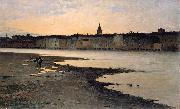 |
Bartolomeo Bezzi -- Click Here
|
|
painted Sulle rive dell'Adige in 1885 |
|
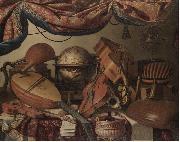 |
Bartolomeo Bettera -- Click Here
|
|
Bartolomeo Bettera (Bergame, 28 août 1639 - Milan, apres 1688) est un peintre italien qui a ete actif dans la seconde moitie du XVIIe sie-le dans la peinture de nature morte. |
|
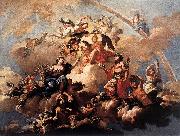 |
Bartolomeo Altomonte -- Click Here
|
|
Bartolomeo Altomonte, also known as Bartholomäus Hohenberg (24 February 1694 - 11 November 1783), was an Austrian baroque painter who specialized in large scale frescoes. He was the son of Martino Altomonte, also a painter. |
|
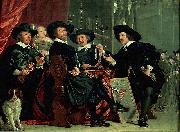 |
Bartolome Perez -- Click Here
|
|
(1634-1693) was a Spanish painter of the Baroque period.
Born in Madrid, he became the son-in-law and pupil of the painter Juan de Arellano. Known as a painter of flowers and still life, known as bodegones. He also painted scenography for performances at the theater of Buen Retiro, for which he was named painter of the King without salary in January of 1689. He died after falling from a scaffold used to paint the ceiling of the palace of Monteleon, and was buried in the church of San Ildefonso.
|
|
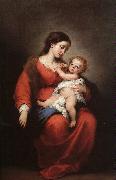 |
Bartolome Esteban Murillo -- Click Here
|
|
Spanish
1618-1682
Bartolome Esteban Murillo Galleries
Murillo began his art studies under Juan del Castillo in Seville. Murillo became familiar with Flemish painting; the great commercial importance of Seville at the time ensured that he was also subject to influences from other regions. His first works were influenced by Zurbaran, Jusepe de Ribera and Alonso Cano, and he shared their strongly realist approach. As his painting developed, his more important works evolved towards the polished style that suited the bourgeois and aristocratic tastes of the time, demonstrated especially in his Roman Catholic religious works.
In 1642, at the age of 26 he moved to Madrid, where he most likely became familiar with the work of Velazquez, and would have seen the work of Venetian and Flemish masters in the royal collections; the rich colors and softly modeled forms of his subsequent work suggest these influences. He returned to Seville in 1645. In that year, he painted thirteen canvases for the monastery of St. Francisco el Grande in Seville which gave his reputation a well-deserved boost. Following the completion of a pair of pictures for the Seville Cathedral, he began to specialise in the themes that brought him his greatest successes, the Virgin and Child, and the Immaculate Conception.
After another period in Madrid, from 1658 to 1660, he returned to Seville. Here he was one of the founders of the Academia de Bellas Artes (Academy of Art), sharing its direction, in 1660, with the architect, Francisco Herrera the Younger. This was his period of greatest activity, and he received numerous important commissions, among them the altarpieces for the Augustinian monastery, the paintings for Santa Mar??a la Blanca (completed in 1665), and others. |
|
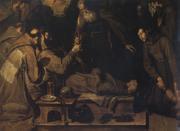 |
Bartolome Carducho -- Click Here
|
|
Italian, 1554-1608 |
|
 |
Bartolome Bermejo -- Click Here
|
|
Spanish Early Renaissance Painter, ca.1405-1498 |
|
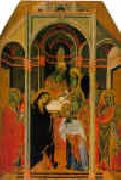 |
Bartolo di Fredi -- Click Here
|
|
Italian Gothic Era Painter, ca.1330-1410
He had a large studio and was one of the most influential painters working in Siena and the surrounding towns in the second half of the fourteenth century. He registered in the Guild of that city in 1355; he had several children, who all died before him, with the exception of Andrea Bartoli. He was the companion of Andrea Vanni from 1353, and helped decorate the Hall of Council at Siena, in 1361. In 1362 he went to San Gimignano, where, by 1356, he had painted the entire side of the left aisle of the Pieve with scenes drawn from the Old Testament. In 1366 the Council of the city of Gimignano ordered a painting, representing Two Monks of the Augustine Order to be placed in the Palazzo Pubblico, in order to commemorate the settlement of some disputes which had long existed between that order and the city. In the early part of 1367 he returned to Siena, and was employed with Giacomo di Mino in the decorations of the cathedral. In 1372 he rose to a position in the government of the city, and was sent to welcome the new Podesta, on his approach to Siena. In 1381 he was himself made a member of the Council, and in 1382 he executed the Descent from the Cross now in the Sacristy of San Francesco, Montalcino. The same church also possesses panels painted by him containing the Baptism of Christ figures of SS. Peter, Paul, and Francis, and five scenes from the life of St. Philip of Montalcino. In 1389, Bartolo, assisted by Luca Thome, painted the altar-piece for the Shoemakers Company, in the Cathedral, and continued from that year until his death to furnish altar-pieces for the cathedral and other churches of Siena, which have now all disappeared.
His style is marked by the rejection of the concrete figures associated with Pietro Lorenzetti to instead favor flatter decorative otherworldly compositions in the manner of Simone Martini and Duccio. He combined a spirit of fantasy with anecdotal details.
The Honolulu Academy of Arts, the Los Angeles County Museum of Art, the Louvre, the Metropolitan Museum of Art, the Mus??e des Beaux-Arts (Chambery, France), the Musee du Petit Palais (Avignon, France), Museo Civico e Diocesano d Arte Sacra (Montalcinothe, Italy), the Museum of Fine Arts, Boston and the University of Virginia Art Museum are among the public collections having paintings by Bartolo di Fredi. |
|
 |
Bartholomeus van der Helst -- Click Here
|
|
1613-1670
Dutch
Bartholomeus Van Der Helst Galleries
Dutch painter. He was the son of a Haarlem inn-keeper and presumably undertook part or all of his training in Amsterdam. His earliest works suggest that the painter Nicolaes Eliasz. Pickenoy was his master. Although van der Helst had probably already established himself as an independent master by the time he married Anna du Pire in Amsterdam in 1636, his earliest known work, a portrait of The Regents of the Walloon Orphanage, Amsterdam (Amsterdam, Maison Descartes), dates from 1637. Stylistically it is close to the work of Pickenoy. His portrait of a Protestant Minister of 1638 (Rotterdam, Boymans-van Beuningen) reveals the influence of Rembrandt. The young artist must have risen rapidly to fame in Amsterdam, for as early as 1639 he received the prestigious commission for a large painting for the Kloveniersdoelen (Arquebusiers or Musketeers Hall): The Civic Guard Company of Capt. Roelof Bicker and Lt Jan Michielsz. Blaeuw (Amsterdam, Rijksmus.), which formed part of the same series as Rembrandt Night Watch (Amsterdam, Rijksmus.). Van der Helst may not have completed this commission until 1642 or 1643. The ingenious arrangement of the figures in a broad composition shows the artist special talent for composing large groups. Pickenoy influence is less noticeable here than in the portrait of 1637; the self-assured poses of the individual figures were to become a characteristic feature of van der Helst work. The successful execution of this portrait established van der Helst reputation: from 1642, when he began to receive an increasing number of commissions for individual portraits, until 1670 he was the leading portrait painter of the ruling class in Amsterdam. From 1642 his technique in portrait painting gradually became more fluent and the rendering of costume materials more detailed. Some typical portraits of his earlier period are those of Andries Bicker (Amsterdam, Rijksmus.), his wife Catharina Gansneb Tengnagel (Dresden, Gemeldegal. Alte Meister) and their son Gerard Bicker (Amsterdam, Rijksmus.), all of 1642, and the Portrait of a Young Girl (1645; London, N.G.). In 1648 van der Helst painted a second civic guard portrait, The Celebration of the Peace of M?nster at the Crossbowmen Headquarters, Amsterdam (Amsterdam, Rijksmus.), a superbly composed and well painted portrait that, until the late 19th century, was considered one of the masterpieces of the Golden Age but later lost popularity because of its smooth and modish execution. It can nevertheless still be regarded as one of the most important group portraits of the 17th century. Its technical perfection, characterized by a well-modelled rendering of the figures and a smooth handling of the brush, dominated the rest of van der Helst oeuvre. |
|
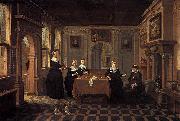 |
Bartholomeus van Bassen -- Click Here
|
|
(1590 - 1652) was a Dutch Golden Age painter and architect.
Van Bassen was born in Antwerp. Little is known of his early life, but according to the RKD he became a member of the Delft Guild of St. Luke in 1613. In 1622 he moved to the Hague, where he became a member of the The Hague Guild of St. Luke two years later and where he became dean in 1627 and headman in 1636 and 1640. He is known for his architectural works, sometimes with staffage by the painters Anthonie Palamedesz, Esaias van de Velde, and Jan Martszen de Jonge. |
|
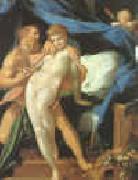 |
Bartholomeus Spranger -- Click Here
|
|
1546-1611
Flemish
Bartholomeus Spranger Gallery
Bartholomeus (Bartholomaeus) Spranger (21 March 1546??August 1611) was a Flemish Mannerist painter, draughtsman, and etcher. He was born in Antwerp.
In 1565, he traveled to Paris and Italy after finishing his studies. He worked on wall paintings in various churches. At Rome, Pope Pius V appointed him court painter in 1570. In 1581 he was appointed to the Prague court of Rudolf II, Holy Roman Emperor.
Hendrik Goltzius made engravings of his paintings, thus increasing Spranger's fame. Spranger's Mannerist paintings depict nudes in various complex poses.
He died in Prague. |
|
 |
Bartholomeus Breenbergh -- Click Here
|
|
(before 13 November 1598 - after 3 October 1657) was a Dutch painter born in Deventer.
Breenbergh established himself in Amsterdam and then in 1619 went to Rome. There he lived and worked with the Flemish painter Frans van de Kasteele and was heavily influenced by another Fleming, the landscape painter Paul Bril. From 1623, however, he came completely under the spell of Italian landscapes by the somewhat older Cornelis van Poelenburgheindeed, the works of Breenbergh and van Poelenburgh are sometimes very difficult of tell apart. Breenbergh in his turn influenced the French painter Claude Lorrain. Breenbergh was one of the founders of the Bentvueghels, where he was nicknamed "het fret".
In 1633 Breenbergh returned to Amsterdam, where he remained until his death, and where he made paintings and etchings of Italian buildings. There he was influenced by the pre-Rembrandtists such as Pieter Lastman and Nicolaes Moeyaert, but he placed their Biblical and mythological scenes in Italian landscapes.
|
|
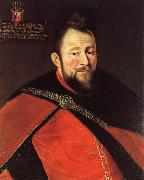 |
Bartholomaus Strobel -- Click Here
|
|
(Breslau 1591-1647 Thorn) was a German baroque painter from Silesia who worked in Poland.
He studied art in the studio of his father. He spent time in Vienna and in Prague. In 1633 he settled in Gdansk and in 1637 operated in Elbing, and thereafter in Torun.
According to Houbraken he received the Dutch painter Gillis Schagen in Elbing in 1637. Strobel was court painter to the emperor at that time, and later became court painter to Władysław IV Vasa, King of Poland.Schagen painted a portrait of the King of Poland to "prove his mastership of the art" for him.
According to the RKD he worked mostly in Prague.
He produced royal court paintings and paintings for the chapel of St.. Kaźmirza in Vilna, (1636-37), and religious paintings in Torue in 1634.
|
|
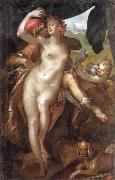 |
Bartholomaus Spranger -- Click Here
|
|
Antwerp 1546-Prague 1611
|
|
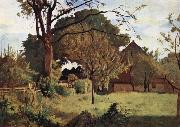 |
Barthelemy Menn -- Click Here
|
|
(20 May 1815 - 10 October 1893) was a Swiss painter and draughtsman who introduced the principles of plein-air painting and the paysage intime into Swiss art.
Menn was born in Geneva as the youngest son of four to Not (Rhaeto-Romance language form for Louis) Menn, a confectioner from Scuol in the canton of Grisons, and Charlotte-Madeleine-Marguerite Bodmer, the daughter of a wealthy farmer from Coinsins in the Canton de Vaud. Already at the age of twelve, Menn took drawing lessons from the little known Jean Duboi (1789-1849), and later, he entered the drawing school of the Geneva Arts Society. The repeated claim that he was also a pupil of the famous enameller Abraham Constantin (1785-1855) appears to be erroneous. In 1831, Menn was second in the annual drawing competition of the Geneva Art Society. The following year, he entered the studio of the Swiss history painter Jean-Leonard Lugardon (1801-1884), who was a pupil of Baron Gros(1771-1835) and acquainted with Jean-Auguste-Dominique Ingres (1780-1867). There, Menn was educated in figure drawing and composition before heading for Paris, where, in fall 1833, he entered the studio of Ingres. He was, therefore, no beginner when meeting the master, but needed some polishing and refinement in his art. In a letter to his friend Jules Hebert, Menn reported on the new situation: eEverybody, even the eldest in the studio tremble before Mr. Ingres. One fears him a lot in such a way that his corrections have a great impact. He is of an extreme sensibility,e while the education in Ingrese studio has been described by Theophile Silvestre, as follows: 'The students spend half of their time studying nature and half studying the masters among which they are especially attached to Phidias, the bas-reliefs of the Parthenon, classical sculpture in general.e This explains why among Menn's early works there are many copies after the Parthenon frieze that was accessible in Paris in a set of plaster casts at the Ecole des Beaux-Arts since 1816. (Fig. 2). Menn also copied several works by Raffael, Titian (Fig. 3), Veronese and Rubens in the Louvre, and works by Ingres.
When the latter decided to give up his studio to take the post as director of the French Academy in the Villa Medici in Rome, Menn returned to his grandparents in Coinsins before following his master in fall 1834. His journey led him first via Milan to Venice, where he met briefly his compatriot Louis-Leopold Robert (1798-1835), and where he would copy works by Titian and Tintoretto. He then travelled via Padua and Bologna to Florence, where he met old classmates from Ingrese studio, and arrived finally in Rome in spring 1835. There, Menn copied works by Raphael and Michelangelo, but he also started to produce extraordinary fresh small landscape paintings in the open air. In summer 1836, he visited the Campagna, Capri and Naples, where too he drew and painted landscapes directly from nature, and copied classical antiquities from Pompeii as well as Giovanni Bellini's Transfiguration in the Museo Borbonico. When back in Rome, he produced history - and genre paintings, of which in 1837, he sent 'Solomon presented to Wisdom by his Parents' (Salomon presente e la sagesse par son pere et sa mere; Fig.N) to the annual Salon in Geneva. Menn returned via Florence, Siena and Viterbo to Paris in late 1838, where he exhibited at the Salon from 1839 to 1843, and where he became the drawing master of Maurice Dudevant, the son of George Sand. In her circle, he became acquainted with Eugene Delacroix (1798-1863) who wanted to employ him as an assistant while working on the decoration of the cupola of the library in the Palais du Luxembourg. At the same time, Menn got to know the painters of the Barbizon School, and especially Charles Daubigny (1817-1878). Most importantly, however, Menn became friends with Camille Corot (1796-1875), who, from 1842 onwards, visited Switzerland frequently. It was also in Paris that he became acquainted with members of the Genevan Bovy family who followed the utopian socialist ideas of Charles Fourier.
|
|
 |
Barthel Bruyn the Elder -- Click Here
|
|
German Northern Renaissance Painter, 1493-1555 |
|
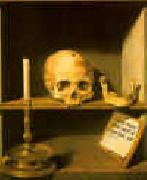 |
Barthel Bruyn -- Click Here
|
|
1493-1555 German
German Renaissance painter, active in Cologne from 1515. Known especially for his portraits, which combine Northern realism with Italian-inspired monumentality and breadth, Bruyn also painted religious works such as the high altar at Essen Cathedral (1522). A portrait of a man and three religious works are in the Philadelphia Museum; many of his works are in Germany. |
|
 |
Barry, James -- Click Here
|
|
Dutch Baroque Era Painter, 1627-ca.1683
Studied under Otto Marseus van Schrieck.
Students included Rachel Ruysch.
|
|
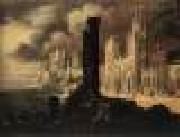 |
BARRA, Didier -- Click Here
|
|
French painter (b. 1590, Metz, d. 1644, Napoli
French painter, active in Italy. He was for a long time confused with FRAN?OIS DE NOM?, and the work of both artists was thought to be by a Mons? Desiderio, a 'highly praised painter of perspectives and city scenes' (de Dominici). It is now generally accepted that Mons? Desiderio was the pseudonym of Didier Barra (1982 exh. cat.), son of Cl?ment Barra. Didier Barra left Metz probably c. 1608, when his name appeared for the last time in the city archives. From c. 1630 he was active in Naples, where he came into contact with landscape and townscape painters from northern Europe. De Dominici wrote that he was associated with Belisario Corenzio. The point of departure in reconstructing Barra's oeuvre is the Panoramic View of Naples (Naples, Mus. N. S Martino), which is signed and dated Desiderius Barra ex civitate Methensi in Lotharingia, F. 1647. The picture is a precise and panoramic view of Naples from the sea, from a single viewpoint, enriched by lively brushwork and with spirited scenes of shipping in the foreground. Its topographical precision suggests that Barra was influenced by the engravings of large views of Naples made by Alessandro Baratta ( fl 1629-30), and he may himself have trained as a cartographer. On the basis of this picture, several views of Naples have been attributed to Barra. |
|
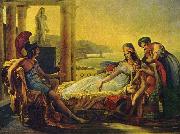 |
Baron Pierre-Narcisse Guerin -- Click Here
|
|
(13 May 1774 - 6 July 1833) was a French painter.
Guerin was born in Paris.
A pupil of Jean-Baptiste Regnault, he carried off one of the three grands prix offered in 1796, in consequence of the competition not having taken place since 1793. In 1799, his painting Marcus Sextus (Louvre) was exhibited at the Salon and excited wild enthusiasm. Part of this was due to the subject - a victim of Sulla's proscription returning to Rome to find his wife dead and his house in mourning - in which an allusion was found to the turmoil of the French Revolution.
Guerin on this occasion was publicly crowned by the president of the Institute, and went to Rome to study under Joseph-Benoît Suvee. In 1800, unable to remain in Rome on account of his health, he went to Naples, where he painted the Grave of Amyntas. In 1802 Guerin produced Phaedra and Hippolytus (Louvre); in 1810, after his return to Paris, he again achieved a great success with Andromache and Pyrrhus (Louvre); and in the same year also exhibited Cephalus and Aurora (Louvre) and Bonaparte and the Rebels of Cairo (Versailles). These paintings suited the popular taste of the First Empire, being highly melodramatic and pompously dignified.
The Restoration brought to Guerin fresh honours; he had received from the first consul in 1803 the cross of the Legion of Honour, and in 1815 Louis XVIII named to the Academie des Beaux-Arts. His style changed to accord with popular taste. In Aeneas Relating to Dido the Disasters of Troy (Louvre), Guerin adopted a more sensuous, picturesque style.
Guerin was commissioned to paint for the Madeleine a scene from the history of St Louis, but his health prevented him from accomplishing what he had begun, and in 1822 he accepted the post of director of the French Academy in Rome, which in 1816 he had refused. On returning to Paris in 1828, Guerin, who had previously been made chevalier of the order of St. Michel, was ennobled. He now attempted to complete Pyrrhus and Priam, a work which he had begun at Rome, but in vain; his health had finally broken down, and in the hope of improvement he returned to Italy with Horace Vernet. Shortly after his arrival at Rome Baron Guerin died, on the 6th of July 1833, and was buried in the church of La Trinite de Monti by the side of Claude Lorrain.
|
|
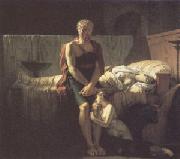 |
Baron Pierre Narcisse Guerin -- Click Here
|
|
Paris 1774-Rome 1833
French painter. He won enthusiastic recognition in 1799 for his Marius Sextus (Louvre). A defender of the classicism of J. L. David, he became director of the École de Rome in 1822. He counted among his pupils Delacroix, G??ricault, and Ary Scheffer, who were to launch the romantic school. |
|
 |
Baron Jean-Baptiste Regnault -- Click Here
|
|
Paris 1754-1829
French painter. His first teacher was the history painter Jean Bardin, who took him to Rome in 1768. Back in Paris in 1772, he transferred to the studio of Nicolas-Bernard Lepicie. In 1776 he won the Prix de Rome with Alexander and Diogenes (Paris, Ecole N. Sup. B.-A.) and returned to Rome, where he was to spend the next four years at the Academie de France in the company of Jacques-Louis David and Jean-Francois-Pierre Peyron. While witnessing at first hand Peyron's development of a manner indebted to Poussin and David's conversion to Caravaggesque realism, Regnault inclined first towards a Late Baroque mode in a Baptism of Christ (untraced; recorded in two sketches and an etching), then, in Perseus Washing his Hands (1779; Louisville, KY, Speed A. Mus.), to the static Neo-classicism of Anton Raphael Mengs. |
|
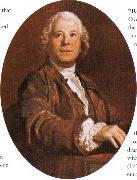 |
baron grimm -- Click Here
|
|
German critic. He worked as a diplomat in Paris from 1749. Influenced by the Encyclopedists, he favoured the use of the Italian style in French operas (especially those of Rameau); in the Querelle des Bouffons of the 1750s he rejected all French music in favour of Rousseau, writing the satirical tract Le petit proph??te de Boehmischbroda (1753) and other works. He was a friend to the visiting Mozart family, 1763-4 and 1778.
|
|
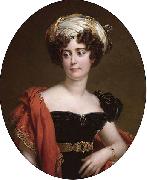 |
Baron Gerard -- Click Here
|
|
There have been three baronies created for descendants of the Gerard family who resided at Bryn, Ashton in Makerfield, Lancashire and Kingsley, Cheshire in the 13th century.
The title Baron Gerard of Gerards Bromley, was created in the Peerage of England on 21 July 1603 for Sir Thomas Gerard (d. 1617), son of Sir Gilbert Gerard (d. 1593) Attorney General between 1559 and 1581 and Master of the Rolls in 1581, who acquired estates at Gerards Bromley and Hilderstone, Staffordshire. The first Baron was Lord President of Wales between 1610 and 1617. The barony passed in direct line of succession until the death of the fifth Baron in 1684 when it passed to his second cousin Charles, and upon his death without a male heir , to his brother Philip Gerard, a Jesuit priest who died childless in 1773 when the barony expired.
The title of Baron Gerard of Bryn in the County Palatine of Lancaster, was created in the Peerage of the United Kingdom in 1876 for Sir Robert Gerard, 13th Baronet. The title followed the line of the first Baron's eldest son until the death of the latter's grandson, the fourth Baron, in 1992. He was succeeded by his second cousin once removed, the fifth and present holder of the barony. He is the great grandson of Captain the Hon. Robert Joseph Gerard-Dicconson, second son of the first Baron.
A Gerard Baronetcy had been created in the Baronetage of England in 1611 for Thomas Gerard, Member of Parliament for Liverpool, Lancashire, and Wigan who was a direct descendant of the family of Bryn. He was succeeded by his son, the second Baronet. He also represented Liverpool in the House of Commons. His son, the third Baronet, was a Royalist during the Civil War and spent a large part of his estate in in his support for King Charles I. His great-great-great-grandson was the aforementioned thirteenth Baronet, who was elevated to the peerage in 1876.
For the title Baron Gerard of Brandon, in the County of Suffolk, created in 1645 for a great-grandson of Sir Gilbert Gerard (mentioned above), see Earl of Macclesfield.
|
|
 |
Baron Francois Gerard -- Click Here
|
|
1770-1837
French
Baron Francois Gerard Galleries
French portrait and historical painter, b. Rome. In Paris, after brief study under Pajou and others, he became a favorite pupil of J. L. David, who influenced such works as Psyche Receiving the Kiss of Cupid and Daphnis and Chloe, both in the Louvre. As a leading portraitist, Gerard was patronized by the court during the Empire and the Bourbon restoration. His portrait of Mme Recamier, of this period, is in the Louvre. Louis XVIII appointed him court painter in 1814. Many examples of his historical paintings are in the Versailles Museum. His portrait of the Countess Regnault de Saint-Jean-d Angely (1798; Louvre) exemplifies his style of studied elegance and meticulous finish. |
|
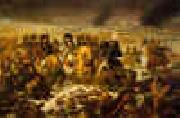 |
Baron Antoine-Jean Gros -- Click Here
|
|
1771-1835
French
Baron Antoine-Jean Gros Galleries
The son of a painter, Antoine Jean Gros was born in Paris on March 16, 1771. At the age of 14 he entered the studio of Jacques Louis David, the acknowledged leader of the classical revival. Although his own work became radically different from David's, he maintained a lifelong respect for his teacher and envisioned himself as the upholder of the Davidian tradition.
In 1787 Gros entered the Acad??mie de Peinture, and when the Acad??mie dissolved in 1793 (a result of the French Revolution) he went to Italy. He met Josephine Bonaparte in Genoa in 1796, and she introduced him to Napoleonic society. Gros entered Napoleon's immediate entourage and accompanied him on several north Italian campaigns. Gros also became involved with Napoleon's program of confiscating Italian art for removal to France.
Gros returned to Paris in 1800 and began to show his Napoleonic paintings in the annual Salons. The most famous of these are the Pesthouse at Jaffa (1804) and Napoleon at Eylau (1808). These works served to deify Napoleon, showing him engaged in acts of heroism and mercy. Stylistically, the paintings were revolutionary:their exotic settings, rich color, agitated space, and general penchant for showing the gruesome specifics of war and suffering differed radically from the cool generalizations of Davidian classicism that Gros had learned as a student. The presentation of contemporary historical events was also new, a harbinger of the realism that developed steadily during the first half of the 19th century in French, American, and English painting. Finally, the emphatic emotionalism of Gros's art established the foundation of romantic painting that Th??odore G??ricault and Eug??ne Delacroix developed after him.
Unlike that of some of his countrymen (David is a case in point), Gros's position did not suffer after the fall of Napoleon. Gros painted for the restored monarchy, for instance, Louis XVIII Leaving the Tuileries (1817), and he decorated the dome of the Panth??on in Paris with scenes of French history (1814-1824). For this Charles X made him a baron in 1824. But these works lack the zest and commitment of Gros's Napoleonic period, perhaps because they were not based on the immediate kinds of historical experiences that had inspired the earlier paintings.
Although marked by considerable public success, Gros's later career was in many ways acutely troubled. Basically, he could not resolve his personal esthetic theories with his own painting or with the work of his younger contemporaries. To the end Gros wished to propagate the classicism of David, and he took over David's studio when the master was exiled in 1816. By the 1820s, however, the revolutionary romanticism of G??ricault and Delacroix, among others, had clearly begun to eclipse classicism, and Gros found himself fighting a lonely and losing battle for conservatism. Ironically, he was fighting a trend that his own best work had helped to originate. As he persisted, moreover, his own painting began to show a diffident mixture of classic and romantic attitudes. Thus, while he was inherently a romantic, he tragically came to doubt himself. Gros died on June 26, 1835, apparently a suicide. |
|
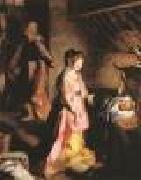 |
BAROCCI, Federico Fiori -- Click Here
|
|
Italian Baroque Era/Mannerist Painter, ca.1535-1612 |
|
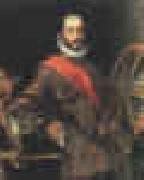 |
Barocci, Federico -- Click Here
|
|
Italian, 1535-1612
.Italian painter. The leading altar painter in Italy in the second half of the 16th century, he enjoyed a greater popularity and exerted a more profound influence on the art of his time than any of his contemporaries. His patrons included the Pope, Emperor, King of Spain and Grand Duke of Tuscany, and among his admirers were Lodovico Cigoli, Annibale Carracci, Rubens and Guido Reni. However, his work did not begin to receive the acclaim accorded that of Tintoretto or El Greco until the mid-20th century. Several factors have obscured his importance, notably the relative inaccessibility and scarcity of his painted works, most of which were done on commission for specific locations in remote parts of Italy (where they have remained), and the type of painting he produced, which was almost exclusively devoted to religious subjects. He executed very few easel paintings. No autograph example of his painted work has ever left Europe, the portrait of Quintilia Fischieri (c. 1600; Washington, DC, N.G.A.) and pair of portraits of Federigo Ubaldo, Prince of Urbino |
|
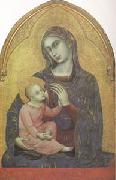 |
Barnaba Da Modena -- Click Here
|
|
active in Genoa and Pisa 1361-1383
was an Italian painter of the mid-14th century Lombardy. There is a painting by him in the church of San Francesco in Alba. A Virgin and Child once in Frankfort, was painted in a Byzantine style and is currently located at the Museum of Fine Arts in Boston, |
|
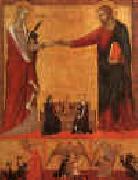 |
Barna da Siena -- Click Here
|
|
Italian Painter, active ca.1350
Barna da Siena, also known as Barna di Siena, was a Sienese painter active from about 1330 to 1350, and was the painter in Siena during this period. He learned his trade from Simone Martini. Barna is believed to have paint the frescoes depicting the life of Jesus in the Collegiata di San Gimignano and is generally credited with Christ Bearing the Cross, with a Dominican Friar in the Frick Collection in New York City. He was killed in a fall from the scaffolding. Barna's figures are more dramatic and vigorous than any in previous Sienese painting. |
|
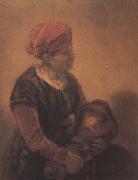 |
Barent fabritius -- Click Here
|
|
Dutch Baroque Era Painter, 1624-1673
Painter and draughtsman, brother of Carel Fabritius. Like Carel, he was first taught painting by his father, also learnt carpentry and practised as an artisan in Midden-Beemster in 1641. He is documented in Amsterdam in 1643 and 1647, though it is not known if, like his brother, he was also a pupil of Rembrandt. Nevertheless, his style is similar to that of the Rembrandt school. He must have been trained in the second half of the 1640s. His work is reminiscent of the style of his brother, who clearly influenced and may also have instructed him. In 1652 Barent lived in Amsterdam and married Catharina Mussers in Midden-Beemster. In the following years he is documented alternately in Midden-Beemster and Amsterdam. He painted a group portrait of the town master builder, Willem Leenderstsz. van der Helm and his Family (1656; Amsterdam, Rijksmus.), in Leiden, and in 1660-61 he received further commissions for the Lutheran church in Leiden. From 1669 Barent lived with his family in Amsterdam, where he died at the age of 49. He was buried in the churchyard in Leiden that was usually reserved for the poorer inhabitants of Amsterdam. |
|
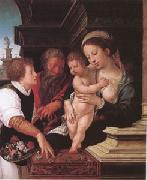 |
Barend van Orley -- Click Here
|
|
Brussels ca 1488-1541 |
|
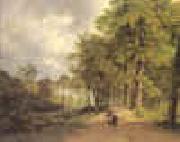 |
Barend Cornelis Koekkoek -- Click Here
|
|
1803-1862
Dutch
Barend Cornelis Koekkoek Gallery
Koekkoek??s own paintings reveal a careful study and synthesis of Dutch seventeenth century painters. His art is firmly rooted in the great Dutch romantic tradition established by the seventeenth-century masters: Hobbema, Cuyp, Ruisdael and Wynants. The golden light and the inclusion of travellers in his work suggests Koekkoek also admired the Dutch Italianate painters of the seventeenth century, collectively known as the Bamboccianti, especially Pieter van Laer and Jan Both.
Koekkoek imagined his pictures as the result of an ideal combination of observation and artifice. He studied art and nature with equal acuity, creating beautiful landscape paintings that celebrated the greatness of Creation. ??Koekkoek's work impresses the spectator by its power, by the firm and correct construction of the trees, by the broad, natural growth of the leaves and boughs, [and] by the careful and elaborate reproduction of the wooded landscape?? (G. H. Marius, Dutch Painters of the Nineteenth Century, Woodbridge, 1973, p. 89). Up to this day, Willem Koekkoek's work is very much favoured for the lively composition and the mood of nostalgia, in which the Dutch Golden Age seems to linger on. Just as he was during his own lifetime, Koekkoek is widely regarded as the most accomplished landscape painter of Dutch romanticism, against whose scrupulously refined paintings the work his contemporaries is measured.
|
|
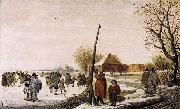 |
Barend Avercamp -- Click Here
|
|
(1612-1679) was a Dutch painter.
Avercamp was born in Kampen and was taught by his uncle Hendrick Avercamp, who was also a painter. Barent primarily painted scenes depicting Netherlands in winter. He was a member of the Guild of Saint Luke, and traveled around the Netherlands including Zwolle and Zutphen for his settings and inspiration.
|
|
 |
Bard, James -- Click Here
|
|
Specializes in Maritime Art
American Painter, 1815-1897 |
|
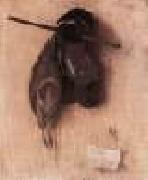 |
BARBARI, Jacopo de -- Click Here
|
|
Italian Early Renaissance Painter, ca.1440-1515
Italian painter and printmaker. He was the first Italian Renaissance artist of note who travelled to the courts of Germany and the Netherlands. His earliest known works appear to date from the late 1490s, suggesting that he was born c. 1460-70. The birthdate of c. 1440 traditionally assigned to him reflects the misinterpretation of a document of 1512 in which his patron, Margaret of Austria, Regent of the Netherlands, awarded him a stipend because of his 'weakness and old age'. In fact, at this date a man could be described as 'old' while in his fifties or even younger. |
|
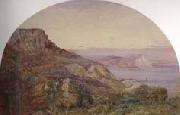 |
Barbara Bodichon -- Click Here
|
|
1827-1891
was an English educationalist, artist, and a leading early nineteenth century feminist and activist for women's rights. She was the illegitimate child of Anne Longden, a 25-year-old milliner from Alfreton, and Benjamin Leigh Smith (1783-1860) , an MP's only son, who was himself a Radical MP for Norwich. Benjamin (Ben) had four sisters. One, Fanny Smith, married into the Nightingale family and produced a daughter, Florence Nightingale; another married into the Bonham-Carter family. Ben's father wanted him to marry Mary Shore, the sister of William Nightingale, now an in law by marriage Ben Smith's home was in Marylebone, London, but from 1816 he inherited and purchased property near Hastings: Brown's Farm near Robertsbridge, with a house built around 1700 (extant), and Crowham Manor, Westfield, which included 200 acres. Although a member of the landed gentry, Smith held radical views. He was a Dissenter, a Unitarian, a supporter of Free Trade, and a benefactor to the poor. In 1826 he bore the cost of building a school for the inner city poor at Vincent Square, Westminster, and paid a penny a week towards the fees for each child, the same amount as paid by their parents. On a visit to his sister in Derbyshire in 1826 Smith met Anne Longden, a 25-year-old milliner from Alfreton. She became pregnant and Smith took her to a rented lodge at Whatlington, a small village near Battle, East Sussex. There she lived as 'Mrs Leigh', the surname of Ben Smith's relations on the Isle of Wight. Barbara's birth created a scandal because the couple did not marry. Smith rode on horseback from Brown's Farm to visit them daily, and within eight weeks Anne was pregnant again. When little Ben was born the four of them went to America for two years, during which time another child was conceived. On their return to Sussex they lived openly together at Brown's, and had two more children. After their last child was born, in 1833, Anne became ill with tuberculosis and Smith leased 9 Pelham Crescent, which faced the sea at Hastings |
|
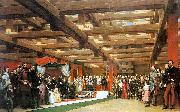 |
Barabas Miklos -- Click Here
|
|
(February 10, 1810 in Mărcuşa, now Romania - February 12, 1898 in Budapest) was a Hungarian painter. He his mostly known for his portrait paintings.
He was born in Kezdimerkosfalva. He spent most of his life in Pest, where he was director of the art society from 1862 until his death. He became a member of the Parliament of Hungary in 1867. He died in Budapest.
|
|
|
|
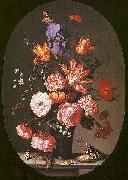 |
Balthasar van der Ast -- Click Here
|
|
(1593/94 - 1657) was a Dutch Golden Age painter who specialized in still lifes of flowers and fruit, as well as painting a number of remarkable shell still lifes; he is considered to be a pioneer in the genre of shell painting. His still lifes often contain insects and lizards. He was born in Middelburg and died at Delft.
|
|
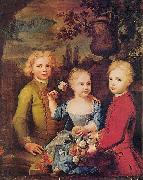 |
Balthasar Denner -- Click Here
|
|
(15 November 1685 in Altona - 14 April 1749 in Rostock) was a German painter, highly-regarded as a portraitist. He painted mostly half-length and head-and-shoulders portraits and a few group portraits of families in interiors. Usually Denner concentrated on the face; clothes and paraphernalia were done by other painters or later his daughter. |
|
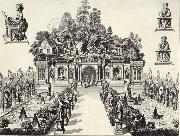 |
Balthasar Anton Dunker -- Click Here
|
|
German, 1746-1807 |
|
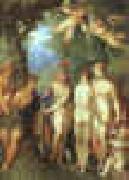 |
Balen, Hendrick von -- Click Here
|
|
Dutch, approx. 1575-1632
Hendrik van Balen
Students included Anthony Van Dyck, Frans Snyders and Gerard Seghers
|
|
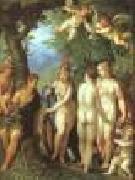 |
BALEN, Hendrick van -- Click Here
|
|
Dutch Baroque Era Painter, ca.1575-1632
Hendrik van Balen (1575 - 1632) was a Flemish painter, who was born and died in Antwerp. Van Balen studied art while traveling in Italy. He was the teacher of Anthony Van Dyck and Frans Snyders and was also a contemporary of many of the other famous Flemish artists, such as the Brueghels, Jan and Peter. |
|
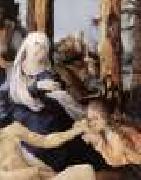 |
BALDUNG GRIEN, Hans -- Click Here
|
|
German Northern Renaissance Painter and Printmaker, ca.1484-1545 |
|
 |
Baldung -- Click Here
|
|
b.c. 1484, Schwäbisch Gm??nd, W??rttemberg [Germany]
d.1545, Imperial Free City of Strasbourg [now Strasbourg, Fr.]
Hans Baldung Gallery |
|
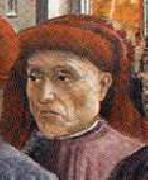 |
BALDOVINETTI, Alessio -- Click Here
|
|
Italian Early Renaissance Painter, 1425-1499 |
|
 |
Baldassarre Peruzzi -- Click Here
|
|
(7 March 1481 - 6 January 1536) was an Italian architect and painter, born in a small town near Siena and died in Rome. He worked for many years, beginning in 1520, under Bramante, Raphael, and later Sangallo during the erection of the new St. Peter's. He returned to his native Siena after the Sack of Rome (1527) where he was employed as architect to the Republic. For the Sienese he built new fortifications for the city and designed (though did not build) a remarkable dam on the Bruna River near Giuncarico. He seems to have moved back to Rome by 1535.
He was a painter of frescoes in the Cappella San Giovanni in the Duomo of Siena.
His son Giovanni Sallustio was also an architect.
|
|
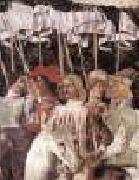 |
BALDASSARE ESTENSE -- Click Here
|
|
Italian painter, Ferrarese school (b. 1443, Reggio, d. 1504, Ferrara) |
|
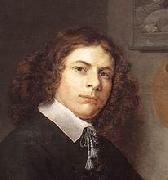 |
BAILLY, David -- Click Here
|
|
Dutch Baroque Era Painter, 1584-1657
Dutch painter and draughtsman. The son of a Flemish immigrant who was a calligrapher and fencing-master, Bailly was apprenticed to a local surgeon-painter and then to Cornelius van der Voort (1576-1624), a portrait painter in Amsterdam. In the winter of 1608 he started out as a journeyman, spending a year in Hamburg and then travelling through several German cities to Venice and Rome. On the return voyage he visited several courts in Germany, working for local princes, including the Duke of Brunswick-Wolfenb?ttel. While no works survive from the immediate period following his return to the Netherlands in 1613, descriptions in old sale catalogues suggest that he may have produced history paintings in the manner of his contemporaries Pieter Lastman and the Pynas brothers. |
|
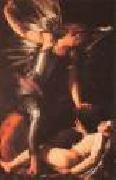 |
BAGLIONE, Giovanni -- Click Here
|
|
Italian Baroque Era Painter, active 1573-1644
A pupil of Francesco Morelli, he worked mainly in Rome, initially with a late-Mannerist style. He was also nicknamed Il Sordo del Barozzo. He published two books, The nine churches of Rome (1639) and The Lives of Painters, Sculptors, Architects and Engravers (active from 1572-1642)(1642). The last title is still seen as an important historical source for painters living in Rome during the life of Baglione.
Among those he chronicled, and for whom he was notorious in his animosity was Caravaggio, whose style had influenced him much. The latter was forced to leave the city after Baglione's accusations of sodomy. Baglione's Sacred love versus profane love, a response to Caravaggio's Love Victorious, shows an angel (Sacred Love) interrupting a 'meeting' between Cupid (Profane Love) and the Devil (portrayed with the face of Caravaggio).
He was employed in many considerable works in Rome during the pontificates of Clement VIII and Paul V. His main works are frescoes which can be seen in the Santa Maria Maggiore in Rome, in the Cappella Borghese. For the church of Santa Maria dell'Orto he painted in the chapel of Our Lady with the Zuccheri scenes from the life of the Blessed Virgin. Among other works which he executed for this church is a painting of Saint Sebastian. An excellent example of Baglione's work is The Last Supper at San Nicola in Carcere. From his brush also there is a Saint Stephen in the Cathedral at Perugia, and in that of Loreto a Saint Catherine. Pope Paul V knighted Baglione a Knight of the Order of Christ for his painting of Saint Peter Raising Tabitha from the Dead (1607) in St. Peter's Basilica. He also painted a St. Stephen for the cathedral of Perugia, and a St. Catharine for the cathedral of Loreto. The Giustizia hall at the Rocca dei Rossi was completely frescoed by Baglione. He died at Rome. |
|
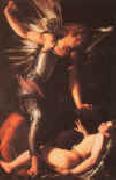 |
Baglione -- Click Here
|
|
1573-1644
Italian painter, draughtsman and writer. He executed canvases and frescoes of religious and mythological subjects, and portraits. He was given important commissions by popes and aristocrats and sold his works to patrons in Italy and abroad. Bagliones arguably greater fame as a writer derives from Le nove chiese di Roma (1639) and especially from his Vite de pittori, scultori, architetti (1642), containing biographies of more than 200 artists who worked in Rome between 1572 and 1642.
|
|
|
|
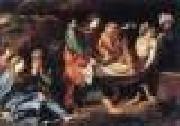 |
BADALOCCHIO, Sisto -- Click Here
|
|
Italian Baroque Era Painter, 1585-ca.1619
Italian painter and etcher. His formation as an artist took place within the Carracci circle. According to Malvasia, he may have attended the Carracci Academy in Bologna, before returning to Parma in 1600 as the pupil of Agostino Carracci when the latter entered the service of Ranuccio I Farnese, 4th Duke of Parma. After Agostino's death in 1602, Badalocchio and his fellow pupil Giovanni Lanfranco were sent by the Duke to Rome in order to complete their training in the studio of Annibale Carracci, who was then working in the Palazzo Farnese. Badalocchio remained with Annibale until the latter's death in 1609. He participated in most of the projects that occupied the studio assistants during those years, such as the frescoes on the walls of the Galleria in the Palazzo Farnese and those previously in the Herrera Chapel in S Maria di Monserrato, Rome (now detached and divided between Madrid, Prado, and Barcelona, Mus. A. Catalunya), although his precise share in them is still debated. His first signed works are etchings, one (1606) after the antique sculpture of the Laokoon (Rome, Vatican, Mus. Pio-Clementino) and 23 (1607, part of a series of 54 executed in collaboration with Lanfranco) after Raphael's frescoes in the Vatican Logge; they reveal the romanizing character of his training. Yet his independent paintings of this early period reveal the influence of Lanfranco, which was to last throughout his career; the lively play of light and shade suggests his allegiance to Emilian art.
|
|
|
|
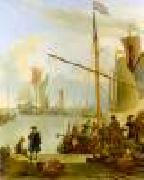 |
BACKHUYSEN, Ludolf -- Click Here
|
|
Dutch Baroque Era Painter, ca.1631-1708
Ludolf Backhuysen (or Bakhuizen) (Dec 28, 1630 - Nov 17, 1708) was a Dutch painter, born in Emden, Hanover.
Bakhuysen started his career as a bookkeeper. He had a very nice handwriting and loved arithmetic. Working for a wealthy merchant at Amsterdam, he discovered so strong a genius for painting that he relinquished the business and devoted himself to art. He studied first under Allart van Everdingen and then under Hendrik Dubbels, two eminent masters of the time, and soon became celebrated for his sea-pieces.
He was an ardent student of nature, and frequently exposed himself on the sea in an open boat in order to study the effects of storms. His compositions, which are numerous, are nearly all variations of one subject, the sea, and in a style peculiarly his own, marked by intense realism or faithful imitation of nature. In his later years Backhuysen employed his skills in etching and calligraphy.
During his life Backhuysen was visited by Cosimo III de' Medici and Peter the Great. In 1699 he opened a gallery on the topfloor of the famous Amsterdam townhall. After a visit to England he died in Amsterdam on November 17, 1708. |
|
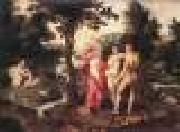 |
BACKER, Jacob de -- Click Here
|
|
Flemish painter (b. 1555/60, Antwerpen, d. 1585/90, Antwerpen)
Flemish painter and draughtsman. According to van Mander, as a young boy de Backer was abandoned by his father, also a painter, who had to flee Antwerp because of an impending court trial. Jacob then worked for several years in the studio of Antonio van Palermo (1503/13-before 1589) and later entered the workshop of Hendrick van Steenwijck. Van Mander further claimed that the strenuous labour that van Palermo had imposed on the young man had so wrecked his health that he died at the age of 30, in the arms of his former master's daughter. This, van Mander added, happened a long time ago, thus implying that de Backer died before van Steenwijck left Antwerp in 1586. This is confirmed by other evidence, including the age of van Palermo's daughter Lucretia, who was baptized in Antwerp on 25 July 1561. She lived until 1626 and at the time of her death still possessed six paintings by de Backer. |
|
|
|
|
| | |
|
|
|
|